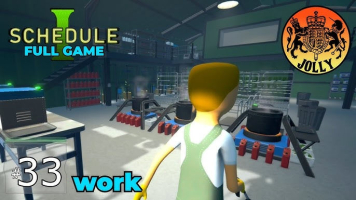


Review
A Minimalist Horror Experience That Gets Under Your Skin
Introduction: A Game That Refuses to Explain Itself
I’ve played countless horror titles over the years — from high-budget thrillers to obscure indie experiments. Yet every so often, a game comes along that doesn’t rely on traditional methods to unsettle its players. Schedule I is one such title. Developed by Icehelm, this minimalistic horror experience strips away the familiar mechanics and tropes of the genre and instead offers something raw, quiet, and deeply unnerving.
It’s the kind of game that leaves you more puzzled after finishing it than you were when you started, and oddly enough, that’s precisely what makes it worth your time.
Atmosphere: Dread in Simplicity
One of Schedule I's most striking aspects is its atmosphere. From the first moments, it wraps you in an oppressive, unnatural quiet. The environments are deliberately low-fi, with harsh lighting, rudimentary geometry, and a sense of digital decay. This minimalist aesthetic isn’t a product of limitations; it’s a deliberate artistic choice. Every empty hallway and stark room feels intentionally wrong.
What makes this experience especially effective is the feeling that you’re being watched — not by some visible entity, but by the world itself. The tension isn’t delivered through loud noises or sudden surprises, but through a slow, building sense of wrongness.
Gameplay: Minimal Interaction, Maximum Impact
Forget weapons, forget inventories, and forget checkpoints marked with glowing icons. Schedule I removes virtually every gameplay mechanic we’ve come to expect. The only thing you can do is move. And yet, this simplicity doesn’t translate to boredom.
The world subtly shifts around you. Corridors stretch a little longer, doors that were once locked now creak open, and new areas materialize without explanation. The unpredictability of these changes keeps you constantly on edge. The game also avoids using explicit puzzles. Instead, you’re left to piece together what’s happening through environmental storytelling, ambiguous symbols, and disjointed fragments of text.
It’s this deliberate vagueness that forces you to pay attention, to question every detail, and to anticipate a threat that never fully reveals itself.
Narrative: Fragmented and Open to Interpretation
There’s no clean, linear story here. Schedule I drops hints, teases possibilities, and leaves everything else to the player’s interpretation. You might stumble upon a screen displaying a sequence of dates or a wall marked with obscure symbols, but their meaning remains elusive.
Several theories surfaced in my mind while playing: Is this a simulation? A memory loop? A psychological experiment? The truth, if there is one, is never spelled out. This ambiguous approach might frustrate those seeking clear answers, but for players like me who appreciate games that trust their audience’s intelligence, it’s a rare and welcome change.
Audio-Visual Design: Subtle Horror Mastery
The soundscape in Schedule I is one of its most impressive tools. There’s no constant soundtrack, just the hum of broken lights, the distant clang of metal, or the faint buzz of malfunctioning electronics. This sparse audio design makes every sudden noise hit harder. A burst of static or a flicker of light feels genuinely unsettling when it breaks the silence.
Visually, the game leans into a deliberately rough style. Blocky textures and environments might seem primitive at first glance, but the way they’re used creates an uncanny valley effect. Spaces feel sterile yet corrupted, mundane yet deeply threatening.
Who Is This Game For?
Schedule I won’t appeal to everyone. If you’re the type of player who enjoys action-heavy horror, complex mechanics, or branching dialogue trees, this might feel too stripped down for your tastes. However, if you’re drawn to atmospheric, experimental titles like Anemoiapolis, Paratopic, or Dread X Collection, you’ll find Schedule I offers a similarly haunting, thought-provoking experience.
It’s a game for those who appreciate mood over mechanics, suggestion over exposition, and quiet horror over cheap thrills.
Final Verdict
Icehelm has crafted a game that’s difficult to categorize. It’s horror, but without the clichés. It’s a narrative, but one without a clear plot. It’s a game, but barely follows traditional rules. And somehow, all these contradictions work in its favor.
While Schedule I may be too abstract or brief for some, those willing to immerse themselves in its fractured world will find a memorable, unsettling experience that lingers long after the final screen fades.
Pros
- Oppressive, minimalist atmosphere that builds unease
- Excellent sound design that amplifies every small disturbance
- Thoughtful environmental storytelling without exposition
- Replay value through subtle world changes and new paths
- Leaves room for personal interpretation and theorycrafting
Cons
- Extremely minimalistic mechanics might alienate some players
- Short runtime compared to more narrative-driven horror games
- Lack of explicit objectives could frustrate completionists















Leave a comment
Your comment is awaiting moderation. We save your draft here
0 Comments